-
Welcome back Guest! Did you know you can mentor other members here at H-M? If not, please check out our Relaunch of Hobby Machinist Mentoring Program!
You are using an out of date browser. It may not display this or other websites correctly.
You should upgrade or use an alternative browser.
You should upgrade or use an alternative browser.
An Electronic Lead Screw controller using a Teensy 4.1
- Thread starter WobblyHand
- Start date
- Joined
- Dec 18, 2019
- Messages
- 6,433
Wire wheeled the straps, they're much better now. Bright, not dull finish. Think I will do a trial spot weld before bothering with the slots. I'll prep a small test piece for that.
- Joined
- Dec 18, 2019
- Messages
- 6,433
Did find some stock and once cleaned, I was able to make ok spot welds. Can't get them apart, without a lot of effort, so it seems the spot welder is fine. It also helped that I was able to plug it directly into a 20A circuit. So wire wheeled the back splash front and back for the straps and fabricated the two straps on the mill. Here they are (uninstalled) on the back splash, and approximately in the right place.
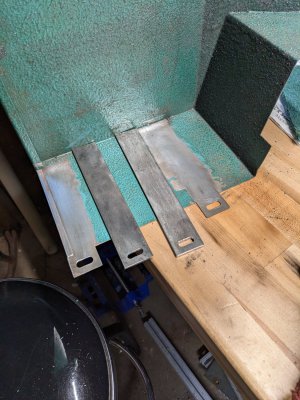
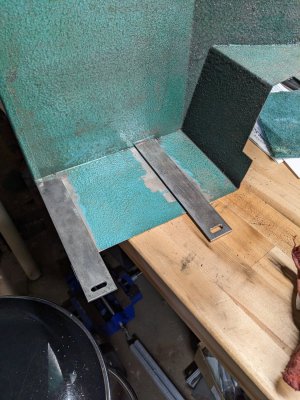
I think I will mill a relief in the left strap for the folded sheet metal. It will be about 0.05" deep and 0.260" wide. I can't quite hold on to the strap in the vise, mill the strap and not damage the jaws. I suppose I could make a soft jaw for one side, or I could just bolt the strap to the table and do it that way. I will check if I have any material for a soft jaw. Haven't made a soft jaw before...


I think I will mill a relief in the left strap for the folded sheet metal. It will be about 0.05" deep and 0.260" wide. I can't quite hold on to the strap in the vise, mill the strap and not damage the jaws. I suppose I could make a soft jaw for one side, or I could just bolt the strap to the table and do it that way. I will check if I have any material for a soft jaw. Haven't made a soft jaw before...
- Joined
- Dec 18, 2019
- Messages
- 6,433
Since I didn't have material in close to the right shape that I wanted to make a soft jaw, I just bolted the strap to the table for milling.
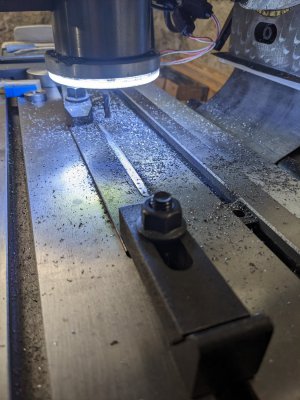
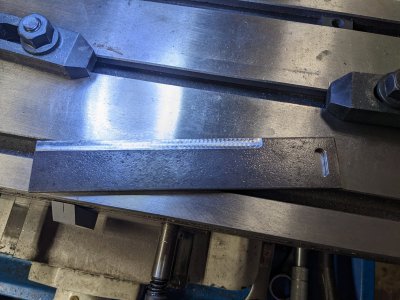
About 0.050" deep and 0.280" wide.
On the back splash, but flipped over.
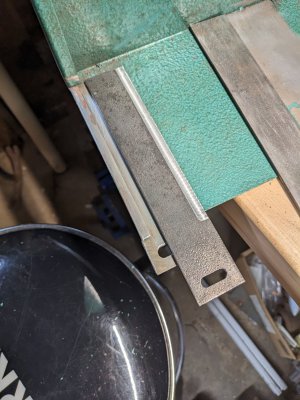
Right side up.
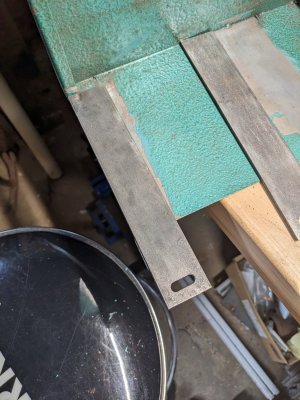
Then clamped the bar to the sheet metal and spot welded it. Here is the back splash hung up on the lathe again. When the bolts/nut are tightened, the back splash is rigidly held. You would think this was success. Sort of.
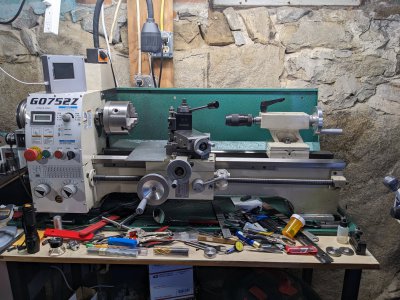
Spacing out the back splash means it is not long enough in some areas to cover things. I knew that in the beginning, but I now have to figure out how to fix it. The bottom is not quite long enough to guide chips to the pan. Also the motor is exposed, which isn't too good. I need to cover this up some, especially in the motor area. On the bottom of the pan is some debris from the DRO install, (old read heads) need to clean that up.
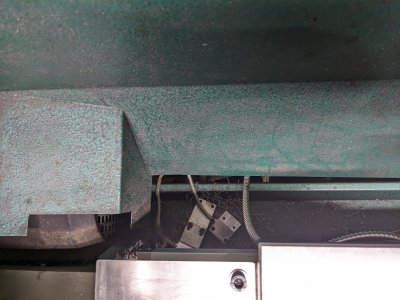
Here is a view looking towards the head stock. You can see the new straps and the spot welds, as well as the uncovered areas.
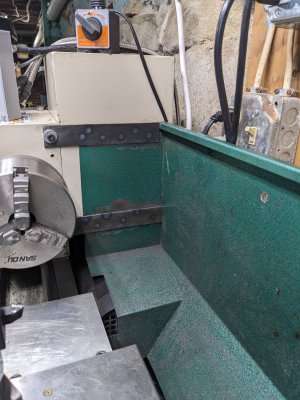
I don't know much about sheet metal, and don't have any tools for it. It will be interesting to figure out a solution. I know I could pop rivet aluminum along the bottom edge to extend the ramp to the tray. Kind of cheesy, but it would work. Be nicer if I could extend the sheet metal. The motor area will be a stretch project for me. Never fabricated sheet metal projects, way out of my experience.


About 0.050" deep and 0.280" wide.
On the back splash, but flipped over.

Right side up.

Then clamped the bar to the sheet metal and spot welded it. Here is the back splash hung up on the lathe again. When the bolts/nut are tightened, the back splash is rigidly held. You would think this was success. Sort of.

Spacing out the back splash means it is not long enough in some areas to cover things. I knew that in the beginning, but I now have to figure out how to fix it. The bottom is not quite long enough to guide chips to the pan. Also the motor is exposed, which isn't too good. I need to cover this up some, especially in the motor area. On the bottom of the pan is some debris from the DRO install, (old read heads) need to clean that up.

Here is a view looking towards the head stock. You can see the new straps and the spot welds, as well as the uncovered areas.

I don't know much about sheet metal, and don't have any tools for it. It will be interesting to figure out a solution. I know I could pop rivet aluminum along the bottom edge to extend the ramp to the tray. Kind of cheesy, but it would work. Be nicer if I could extend the sheet metal. The motor area will be a stretch project for me. Never fabricated sheet metal projects, way out of my experience.
- Joined
- Dec 18, 2019
- Messages
- 6,433
The sheet metal I have in the garage is too thick. It's about 0.071" vs. the 18 gauge (0.048") of the back splash. I just ordered a strip of 18 gauge cold rolled steel, 3" wide, 48" long. Hope that will do it. Plan is to butt weld onto the back splash. Never done that before, save for a couple of tacks. It will be fun. If worse comes to worse, I will be able to spot weld it, if I need to. I need about 2.5" to cover the gaps, so it would work out either way.
Good luck welding/tacking that sheet metal. The "box" area on my backsplash was too big and the carriage hit it which limited travel by about 1/2" or so closest to the chuck. It was also going to be tighter than i'd like once i mounted the DRO scale so i trimmed an inch or so off from it and capped it. I'm talking about a sheet metal cap parallel and closest to the ways. I'm not sure what the metal is but it didn't want to weld. I made it work but i've been careful not to post pics of that embarrassing mess.  I think it'll hold fine and it is sealed up enough to keep chips away from the motor but it just looks like crap. I can only assume that they back splashes are somewhat universal and that's why the motor box area i so much larger than it needs to be. Your motor fills that area much more than mine - i wonder if they kept the same design even after they switched to variable speed DC motors that are smaller?
I think it'll hold fine and it is sealed up enough to keep chips away from the motor but it just looks like crap. I can only assume that they back splashes are somewhat universal and that's why the motor box area i so much larger than it needs to be. Your motor fills that area much more than mine - i wonder if they kept the same design even after they switched to variable speed DC motors that are smaller?
The spot welded strips look nice. A little green hammer paint and no one would be the wiser.
The spot welded strips look nice. A little green hammer paint and no one would be the wiser.
- Joined
- Dec 18, 2019
- Messages
- 6,433
Thanks for the wishes. Don't know how well my tack welding will go. Hah hah, they make it look so easy in the videos. I will cut a few strips and practice with my MIG. No idea what settings to use, but I'll figure it out, at least for the new material. Since the back splash is relatively long, it will be prone to distortion. So this would be like doing automotive sheet metal work. Hope it doesn't turn into a disaster...Good luck welding/tacking that sheet metal. The "box" area on my backsplash was too big and the carriage hit it which limited travel by about 1/2" or so closest to the chuck. It was also going to be tighter than i'd like once i mounted the DRO scale so i trimmed an inch or so off from it and capped it. I'm talking about a sheet metal cap parallel and closest to the ways. I'm not sure what the metal is but it didn't want to weld. I made it work but i've been careful not to post pics of that embarrassing mess.I think it'll hold fine and it is sealed up enough to keep chips away from the motor but it just looks like crap. I can only assume that they back splashes are somewhat universal and that's why the motor box area i so much larger than it needs to be. Your motor fills that area much more than mine - i wonder if they kept the same design even after they switched to variable speed DC motors that are smaller?
The spot welded strips look nice. A little green hammer paint and no one would be the wiser.
The strips came out ok. After welding there were some stresses that slightly warped the top section of the sheet metal, causing it to move slightly away from the head stock, but a screw pulled it back into place. After this is done, I'll have to find some of that green hammer tone paint. It may deemphasize some of my inept work.
- Joined
- Dec 18, 2019
- Messages
- 6,433
Spent part of the day, cutting and truing sheet metal. I bought a 3"x48" strip of 18 gauge steel. Since it didn't want to warp it, using snips, I used a cut off wheel to slice pieces off. Then I squared them up and trimmed them to length on the mill. Tomorrow will be the moment of truth. Have to remove the back splash and bring it to the garage where the welder is. Going to be interesting clamping this, as it will probably have a mind of its own. Anyways, here's the pieces. Somehow they should do the trick, if I don't mess it up. Hope this mad plan works...
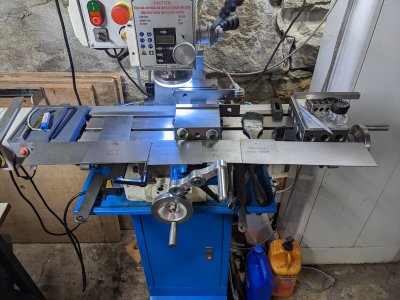

- Joined
- Dec 18, 2019
- Messages
- 6,433
Finished up the pieces, and did a combination of rivets, spot welds and Mig tacks to get it done.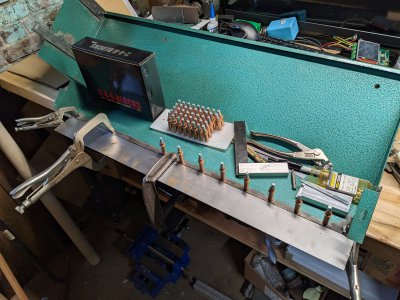
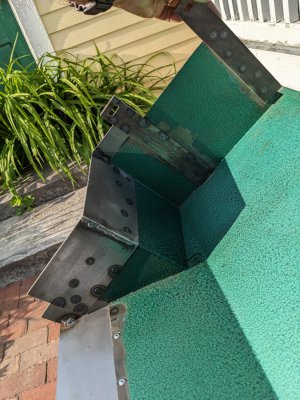
Cleaned and primered it.
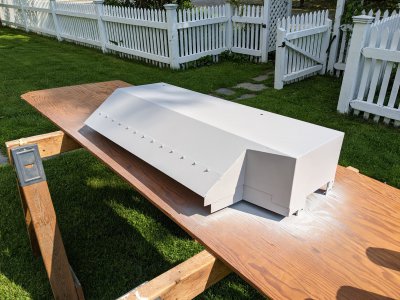
Then I painted it safety blue, which sort of matches my mill.
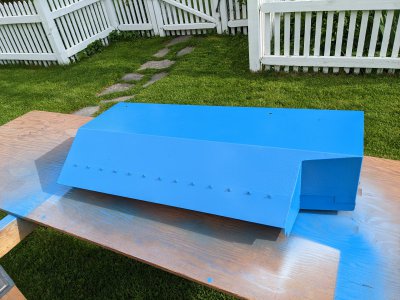
It's in the garage now for the evening. Maybe late tomorrow it will be installed on the lathe. Glad to have gotten this done! This kind of work is not my forte. Should be good enough for what I need. If not, I'll fix it.


Cleaned and primered it.

Then I painted it safety blue, which sort of matches my mill.

It's in the garage now for the evening. Maybe late tomorrow it will be installed on the lathe. Glad to have gotten this done! This kind of work is not my forte. Should be good enough for what I need. If not, I'll fix it.
- Joined
- Dec 18, 2019
- Messages
- 6,433
All done and installed. This whole ELS project, save for any add-ons like feeding and threading to a stop is complete. I'm really pleased with how well this all came out. It is so nice just to be able to dial in the feed, or thread that I want and it just works. Don't have to worry about odd threads, or unobtainable gears because I can just simply program a new thread, so if I wanted 18.55 TPI, I could do it.
That's the new bright backsplash in the background, and part of a circle cutter I made (and used today).
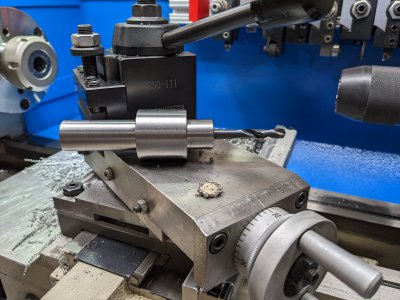
Here's the completed circle cutter after cutting a hole in a steel ammo box. I only wiped off the chips and oil in that picture, I didn't clean up the hole, because it didn't need much.
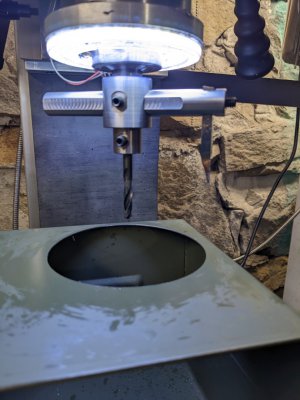
That's the new bright backsplash in the background, and part of a circle cutter I made (and used today).

Here's the completed circle cutter after cutting a hole in a steel ammo box. I only wiped off the chips and oil in that picture, I didn't clean up the hole, because it didn't need much.

Last edited:

